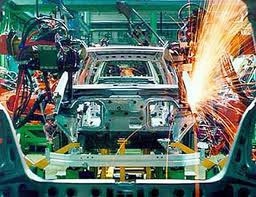Vietnam plans to build national automobile centre
 |
A “super-incentive package” for the project has been suggested, which will benefit Truong Hai, Kia and Hyundai first.
The idea of establishing a national automobile industry center, for the first time, has been put forward which is believed to make a breakthrough and help settle the existing problems in Vietnam’s automobile industry. The “heart of the Vietnam’s automobile industry” in the next 10 years will be located in Chu Lai Economic Zone.
The investment promotion for the centre has shown positive signals with two big partners from South Korea.
Kia Group has agreed to resume negotiations with the Chu Lai Open Economic Zone’s management board on a project to manufacture and assemble cars with the capacity of 100,000 cars a year, which would become operational from 2015.
The investor will have to commit to export 70 per cent of the total output, have the localisation ratio of 47 per cent in the first year of operation, while the ratio must be raised to 60 per cent by the year, when the factory runs at full designed capacity.
The second important partner is Hyundai. The group has signed an agreement with Vietnamese Truong Hai Automobile, under which Truong Hai will act as the sole distributor of Hyundai vehicles in Vietnam. Meanwhile, Hyundai will set up an engine production factory with the output of 10,000 products a year for local consumption in the first period, and 50,000 products a year for export to China in the second period, which will come after 2015.
The Quang Nam provincial authorities hope that the above said projects by the two South Korean automobile groups would be the premise for Vietnam to build the national multi-purpose mechanical engineering and automobile centre.
If everything goes smoothly, an investment agreement would be signed this year, so that the projects could be kicked off by June 2012.
According to the Ministry of Industry and Trade, in 2016-2020, Vietnam would need 70,000-100,000 passenger cars a year. The existing assembling factories need to increase the output and the localisation ratio of products to improve the competitiveness, or they have to build new factories which can meet the requirements.
However, with the import tariff expected to reduce to zero per cent from 2018 to be applied to ASEAN sourced products, small scale assembling factories would not survive. The establishment of a national automobile center, which attracts the enterprises which have technological capability, would help Vietnam’s automobile industry resist the anticipated challenges.
With such a noble mission, the national automobile center will get very big investment incentives.
Quang Nam’s authorities have proposed the government to exempt the land leasing fee for the whole life of the project, while the state will prop up the compensation for site clearance.
Meanwhile, the Ministry of Finance thinks that the land leasing fee should be exempted for the construction period and for the first 11 years after the project completes.
Regarding the taxes, Quang Nam plans to impose 10 per cent of corporate income tax for 30 years (other enterprises in the same zone enjoy the 10 per cent tax rate for 15 years), and exempt the tax for the first 10 years instead of four years.
Besides, the investors would also enjoy the 50 per cent tax reduction in the next nine years.
The collection of other kinds of taxes, including import tax and luxury tax should be delayed for five years in 2015-2019. The State budget should support the consumption of 30 per cent of products on the domestic market, which is equal to the total sum of luxury tax to be paid for 50 per cent of products for five years.
The government has also proposed to give support by purchasing the cars for state agencies.
Quang Nam has also proposed to apply the regulations of export processing zone (EPZ) to Hyundai and Kia.
However, the two special preferences have been rejected by the Ministry of Finance.
What the stars mean:
★ Poor ★ ★ Promising ★★★ Good ★★★★ Very good ★★★★★ Exceptional
Related Contents
Latest News
More News
- Amata City Ha Long fosters collaboration with Chinese manufacturers (December 04, 2025 | 15:07)
- Phu Tho accelerates industrial growth as post-merger economy gains momentum (December 04, 2025 | 11:45)
- Education reforms aid dealmaking appeal (December 03, 2025 | 10:07)
- Manufacturing deals bring stronger supply chains closer (December 03, 2025 | 09:34)
- Vietnam to limit raw rare earth exports (December 02, 2025 | 17:08)
- Japanese embassy marks 20 years of Japan-ASEAN bond market support (December 02, 2025 | 16:57)
- Phu Tho accelerates digital transformation to drive business growth (December 02, 2025 | 16:20)
- Vietnam-Czech collaboration to expand in key areas (December 02, 2025 | 15:36)
- GG Industries to produce high-tech battery storage with Goldwind tech (December 02, 2025 | 10:08)
- Manufacturing growth holds steady despite storm disruptions (December 02, 2025 | 10:06)

 Tag:
Tag:



















 Mobile Version
Mobile Version